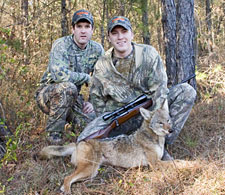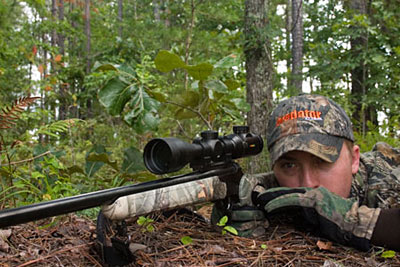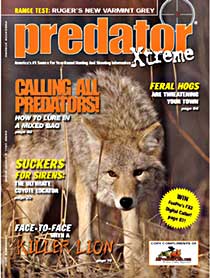Simply walking into the hills and blowing on a predator call is a recipe for failure. Here are nine basics to success that can be employed at any time, on any animal that falls into the category of predator.
 Hunt In Pairs
Hunt In Pairs
Hunt with a partner. Two sets of eyes are better than one. Two can sit back to back covering all approaches 360 degrees even in thick cover. One person can’t match this, and has to move a good deal, which is a dead give-a-way. Predators notice movement quickly. Two hunters can also separate, one calling, while his amigo stations himself 20 or 30 yards away at varying angles. Animals coming to a call have their attention on the caller and not the one off to the side lifting his weapon. It’s deadly.
Use Extra Calls
I carry at least two, sometimes three mouth calls from different manufactures. Start a series of calls with the loudest, that reaches farthest, then switch to a second or third one with less volume and more muted tone as animals approach. Sometimes, when one call does not get a response, switching to a different volume or sound will. Variety is important.
Check Waterway Sign
Check for predator sign along any stream, or river, including dry ones. These are natural travel lanes, but are also areas they spend time hunting. Prey animals are found near water, whether it’s mice, ground squirrels, or jackrabbits. Fresh tracks or scat can tell you how often these places are being frequented, and by how many animals. Setting up stands near water will help up your odds, especially early and late in the day when predators are doing a lot of traveling.
Match Stands To Cover
In flat, open country, move at least one mile between stands. Your calls can be heard that far by sharp eared predators. In hilly, chopped up country, or thick cover, make two or three stands over the same distance because sounds are muted by terrain. Windy or snowy days also have a dampening effect, so you can make stands closer together.
Use Elevation
Elevation of some kind should always be sought. Trees, rock piles, a saddle or modest rise above surrounding areas, makes a big difference. With even a little elevation, the caller holds all the aces. His calls go farther covering more area. He can see animals coming to him a long ways out and set up ready for a shot before the predator gets in range. Dressed in full camo, blending in with rocks, brush, and trees, you will not be seen if you use your head and only move when it’s time to take the shot. See them before they see you!
Watch The Wind
Many novice predator hunters don’t pay attention to wind direction or force. Coyotes pay attention to wind. Fox do also, but cats seem to pay the least. If you want to call a particularly good looking canyon or flat, but the wind is at your back, move to one side so your scent does not permeate that piece of ground. Getting off the ground (elevation), helps keeps scent above ground level. Air currents tend to rise at dawn and fall in evening. Don’t announce your presence on the wind.
After The Shot

Get away from your vehicle. A short hike of 100 yards can make the difference between success and failure. Wary, call-wise predators will shy away from the flash and form of vehicles. You want to get away from engine noise, mechanical smells, and the sound of driving in over gravel, dusty or brushy roads.
No animal keys its daily life cycle by weather more than predators. Their high and low period of activities follow these natural events. Rainy days, heavy snow, intense heat, all mean minimal travel and hunting as they hole up waiting it out. When weather clears, predators go hunting, making up for lost time and shrunken stomachs. Clear days after rains, cold but sunny days after snowfall, moderating temperatures after high heat, all produce increased hunting activity. Capitalize on these changes by being out at first light, making multiple stands all day, because predators hunt daylong after a storm.
